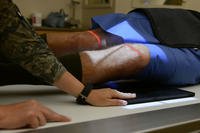SARATOGA SPRINGS, N.Y. -- New York's State Fairgrounds, some four miles outside of Syracuse, are 3,587 miles away from the trenches that cut across France during World War I, but in 1917 and 1918, the grounds were part of America's war on the German Empire.
In May 1917, the Army opened a mobilization base on the fairgrounds, which had been purchased by the New York State Agricultural Society in 1890 and then acquired by New York State in 1899.
In 1917 and 1918, about 40,000 soldiers reported for their initial duty at Camp Syracuse and then were moved on to other bases for additional training and assignment to a division.
Initially, Camp Syracuse provided a local mobilization site for National Guard soldiers and other new volunteers for service in the Regular Army.
At just four miles from downtown Syracuse, it was an ideal site for the mobilization of Central New York Guardsmen and Army volunteers.
Some 17,000 soldiers would process through the mobilization camp in the first year of the war, including 3,500 local area National Guard soldiers of the newly designated 27th Infantry Division.
Elements of the Army's 9th and 16th Infantry Regiments, along with the 5th Machine Gun Battalion, were stationed there to operate the camp and provide instruction to the mobilizing troops.
While the Army occupied much of the 100-acre state fair site, the 1917 New York State Fair was held as planned from Sept. 10-15. Soldiers with time off could visit a new $200,000 horse exhibit building, take in the New York State Vegetable Tower and see members of the newly formed New York State Police showing off their horsemanship skills during grandstand shows.
A total of 141,045 New Yorkers visited the state fair that year, even though the grounds were also one of the largest military facilities in the United States.
While the residents of Syracuse mobilized their own citizenry for the war, they also would crowd city streets for the send-offs of the soldiers completing their training at the nearby camp.
The largest farewell for the war effort in Syracuse was May 26, 1918, when 15,000 people turned out in support of 571 new Syracuse soldiers as they marched to the train station for their wartime duties.
By the summer of 1918, however, the camp took on a new role: training new draftees for "special and limited service." These were the Army's soldiers otherwise unqualified for combat ("full") duties.
As soldiers drafted for service in the National Army -- divisions made up of soldiers who were not in the National Guard or the Regular Army -- began reporting to medical examining stations, Army doctors discovered that not all were ready for combat.
Draftees were divided into four classes. Group A consisted of men who were ready for military training. Group B was composed of inductees who had a physical defect that could be remedied and then they could go to war. Group C consisted of men who had one of 269 conditions that would prevent them from serving in a front-line capacity but who could still serve. Group D were the soldiers who, in other wars, would be labeled "4-F," unfit for military service of any kind.
There were some 269 physical limitations that would categorize a WWI draftee as fit for only limited service. Some examples include curvature of the spine, arthritis, defective vision or hearing, heart disorders, flat feet, underweight, obesity, asthma or blindness in one eye.
While extreme cases or multiple ailments would be cause for outright rejection by the armed forces as Group D, those soldiers who processed through Camp Syracuse were considered essential for rear echelon duties. After their training at the Syracuse Recruitment Camp, troops went on to assignments around the country for fire and guard duty at both military and essential civilian sites, such as harbors, bridges or factories, with many assigned to guard the Erie Canal right in New York State.
The Army decided that Camp Syracuse would be the place the 26,000 men in Group C would be processed.
On July 19, 1918, the camp was renamed the Syracuse Recruit Camp and taken over by the Army's 22nd Infantry Regiment.
Major (Temporary) Samuel G. Talbot was put in charge of the camp and ran it for a month until Lt. Col. (Temporary) Brady G. Ruttencutter took over. Ruttencutter commanded the camp for the rest of its existence.
In September 1918, 10,000 recruits arrived at the camp, and so did the influenza epidemic that was making its way around the world. More than 2,289 soldiers would be diagnosed with influenza and 208 died.
Despite that, the New York State Fair was still held next door to the military camp, with 131,557 people going through the turnstiles during the six days of the fair.
When the epidemic ended in October, the Army was eager to close down the camp so that the flu did not break out again. Soldiers were moved out of the Syracuse Recruit Camp.
The men of the 22nd Infantry Regiment who ran the camp were the last to go and left in three increments.
One company left for New Jersey on Oct. 19 while two other companies went to Fort Jay, New York, on Nov. 19. On Nov. 20, 1918, the 22nd Infantry Regiment's Supply Company and Machine Gun Company left for Fort Hamilton in Brooklyn, and Camp Syracuse was no more.
Want to Know More About the Military?
Be sure to get the latest news about the U.S. military, as well as critical info about how to join and all the benefits of service. Subscribe to Military.com and receive customized updates delivered straight to your inbox.















